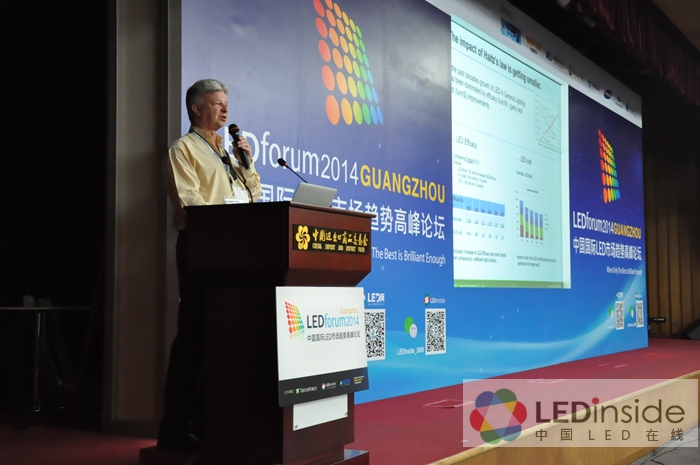LED manufacturers involvement in smart lighting has become an unstoppable global trend, according to Marten Willemsen, Vice President, Global Marketing, Seoul Semiconductor.
Willemsen focused on the company’s latest Acrich technology during his speech at the LEDforum 2014 Guangzhou held at China Import and Export Fair Pazhou Complex of Guangzhou International Lighting Exhibition (GILE) 2014 on June 11, 2014.
 |
|
Marten Willemsen, Vice President, Global Marketing, Seoul Semiconductor speaking at LEDforum Guangzhou 2014, which was held at the show grounds of Guangzhou International Lighting Exhibition 2014 on June 11, 2014. (LEDinside) |
Acrich is the world’s first LED package product that can be directly plugged in, and does not require current-to-voltage conversion, said Willemsen. This feature also highlights LED’s long lifetime and easy design. The company’s Acrich MJT component can simplify the power module design, while the Driver IC can replace earlier large-sized power modules.
The company’s latest Acrich 3, especially designed for smart lighting has the features of low Total Harmonic Disruption (THD), high power factor (PF), high reliability and excellent Triode for Alternating Current (TRIAC) dimming compatibility. Flicker was reduced by controlling dimming area. Compared to conventional LED dimming systems, Acrich 3 is capable of meeting NEMA SSL 6 dimming demands, and has made significant improvements in dimmable LED systems compatibility.
In addition, Acrich 3 can easily connect with many smart lighting systems including Zigbee, Wifi, Bluetooth, infrared (IR), motion sensors and others. The LED package can realize the most commonly dimming light models in industrial and commercial lighting. The lighting can be applied to buildings, parking lots, factories and warehouse lighting. Seoul Semiconductor spent four years developing the module, and will be using Acrich 3 to target the residential, commercial, industrial, and streetlight market in U.S. and Europe.
Smart lighting can greatly add value to lighting products as integrated smart controls and LED lighting change the way people use lighting. Smart lighting is providing the lighting industry a long term growth momentum. Even though, smart lighting controls still have room for improvement, it will no doubt become the LED industry’s greatest advantage. To gain an advantage in LED smart lighting era, many manufacturers are no longer focused on dimming or color tuning features in their products.
Instead, these manufacturers are exploring the entire lighting system and smart lighting controls. The starting point of these products is harmony between people and the environment. These manufacturers are also exploring client usage demands, which integrate general lighting and ambient lighting. This will unveil the new lighting application era with core values in integration, intelligence and energy efficiency.
Willemsen also noted the influence of Haitz Law is gradually decreasing over the years. The law was first proposed by retired Agilent Technologies Scientist Roland Haitz, who based the law mostly on observations of LED commercialization developments from 1965 to 2003. The law is recognized as the Moore Law of the LED industry. According to Haitz’s LED product statistics compiled from the first commercialized product in 1965 to 2003, he found LED brightness doubled every 18 to 24 months.
Haitz Law projects 100 lm/W LED will first appear on the market sometime from 2008 to 2010. In reality, LED developments have been slightly faster, said Willemsen. Over the last few decades, increase in LED market penetration rates are mostly because of rising luminous efficacy and decreased costs.
(Author: Nicole Lee, Editor, LEDinside Chinahttp:// Translator: Judy Lin, Chief Editor, LEDinside)





 CN
TW
EN
CN
TW
EN





